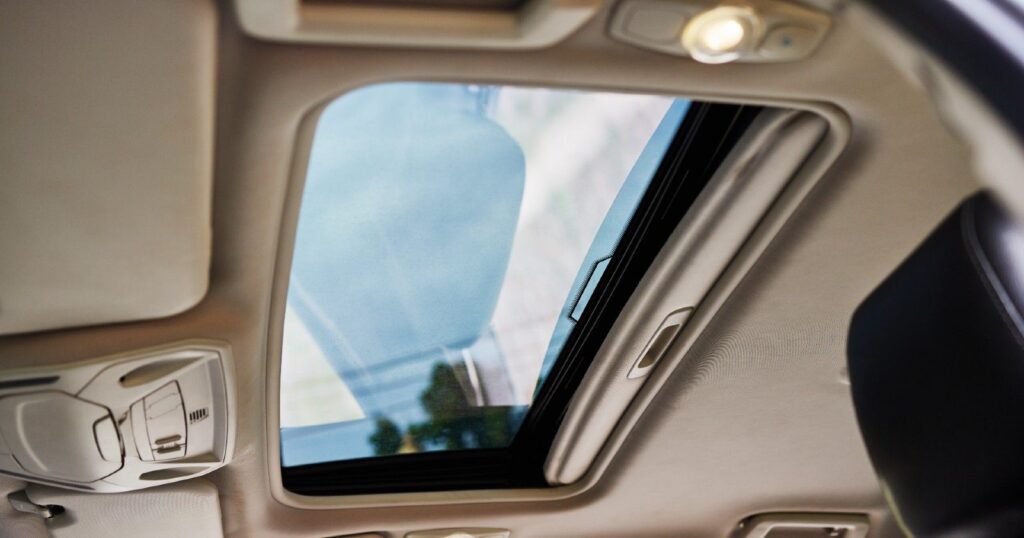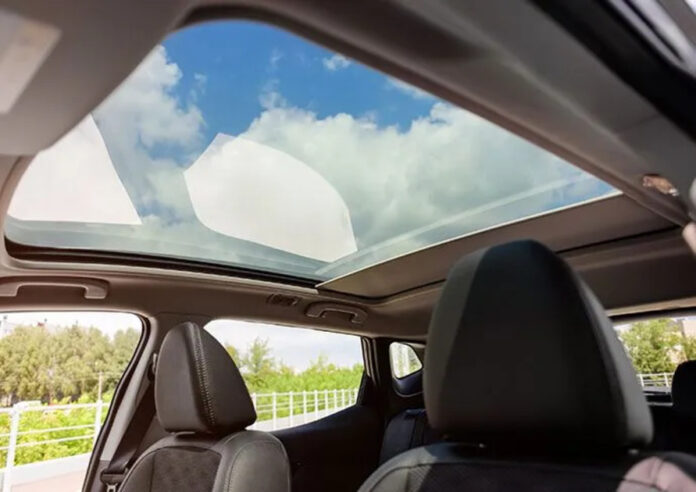A sunroof stuck open can be frustrating—especially if it rains unexpectedly. You can shut the sunroof manually by finding the manual override switch near it and turning it off. If that doesn’t work, removing the motor might be your next option. Knowing these steps can help keep your car dry. Follow along as we walk through your options to stay protected from the elements.
How a Sunroof Works
Knowing how a sunroof operates helps when you need to close it by hand. This includes understanding the motor and how manual options come into play when it stops working.
Components of a Sunroof
A sunroof is made up of several components. The sunroof panel is what moves back and forth. The sunroof motor is a vital part, connected to a system of gears and cables that move the panel.
Cables transmit the motor’s motion to the sunroof. Gears make this transfer more efficient. Knowing where these parts are and what they do can help if you need to operate the sunroof manually.

How the Sunroof Motor Works
The sunroof motor is small but strong. When you press the open or close button, it powers gears connected to the panel via cables.
If everything is working well, the panel slides smoothly. Understanding this helps you troubleshoot. Knowing where the motor is also makes manual adjustments or repairs easier.
Manual Override Systems
Some vehicles include a manual override system for use in case of failure. This usually means there’s a hidden switch or crank you can use. It’s often behind a panel near the sunroof.
Once found, insert the crank or use the switch to operate the sunroof manually. Some vehicles also have a ceiling switch that disables the motor and enables manual use. Knowing where these options are is a big help if the motor fails.
When and Why to Close a Sunroof Manually
Sometimes you’ll need to shut your sunroof manually—usually because it’s stuck or water is getting in. Understanding what causes these problems can help avoid bigger issues.
Common Reasons for Manual Closure
Electrical issues or worn components can cause the motor to stop working. You might need to close the sunroof manually to stop rain from soaking your interior.
Sometimes, dirt or debris blocks the sunroof tracks. This can stop the panel from closing completely and let water in. Fixing it quickly avoids interior damage and repair costs.
A faulty control switch could also be the issue. In such cases, manual closure might be your only option. Having some tools and basic knowledge can really come in handy.
Assessing Your Sunroof’s Condition
Before trying to close the sunroof yourself, inspect it first. Look for any dirt, leaves, or objects stuck in the track.
Next, check the seals for cracks or damage. Bad seals can let water in and cause rust or mold over time.
Also listen for any odd noises while operating the sunroof. Clicking or grinding might mean mechanical trouble that could stop the panel from closing properly. If you notice this, it’s best to go manual until repairs can be made.
Getting Ready to Close It
Before you try to close your sunroof by hand, make sure you’re ready. This means having tools nearby and clearing the area around the override mechanism.
Tools You’ll Need
To close your sunroof manually, you will need a few key tools. First, find a hex wrench, as this is commonly used for operating the manual closure. Check your vehicle’s manual or tool kit that might contain the right size.
Next, have a flashlight handy. It helps to see clearly in dark areas like the headliner where the manual override is located. Keep a small screwdriver ready too, as you might need it to remove any small covers or panels to access the manual controls.
Make sure you have a soft cloth. This will help you clean any dust or debris around the manual mechanism, which might otherwise interfere with its operation. Being prepared helps the process go smoothly.
Clearing Access to the Manual Override
Accessing the manual override spot is essential for operating the sunroof manually. Look for a small panel or cover on your car’s headliner, which is often near the sunroof area. This is where you’ll find the manual override mechanism.
Gently remove the panel using your fingers or a screwdriver. Take care not to damage it or the surrounding areas. This ensures you have clear access and prevents unnecessary repairs.
Once it’s open, inspect the area. Ensure there’s no dirt or obstructions that might block your tools or interfere with the mechanism. Removing obstacles will make it easier to insert the hex wrench and perform the necessary actions to close the sunroof.
Step-by-Step Guide to Closing Your Sunroof
Closing a sunroof manually can seem tricky, especially if you’re not familiar with the process. You need to locate the manual override, work carefully to close the sunroof, and ensure everything is secure once it’s closed.
How to Find the Manual Override
Begin by locating the manual override mechanism. This feature is usually hidden behind a small panel, typically near the sunroof or embedded in the roof lining (headliner). To access it, use a tool like a flathead screwdriver to gently open the cover that protects this mechanism.
Depending on your vehicle model, you will either see a crank handle or a slot for a hex key. Having the correct tool for your specific system is important, as it’s what you’ll use to manually operate the sunroof.
Steps to Manually Close the Sunroof
Once you’ve accessed the manual override system, you can begin the process of closing the sunroof. Insert the crank or hex key into the slot provided and turn it gently. As you rotate the tool, you should hear or feel the internal gears working to move the sunroof.
Apply consistent, steady pressure while turning to avoid damaging the gear system. If the sunroof isn’t moving easily, check that the tool is properly positioned. You may also need to slightly shift the cable to allow for smoother motion.
Ensuring the Sunroof Is Fully Closed
After closing the sunroof manually, it’s important to confirm it’s securely shut. Make sure it lines up with the roof of your car and that there are no visible openings. Lightly press along the edges to verify that the sunroof is firmly sealed.
If your vehicle has an extra locking feature or latch, make sure to engage it. Once everything is secure, replace the panel cover over the manual override. It’s also a good idea to store your tools in an accessible place in case you need them again in the future.
Fixing Common Sunroof Problems
A sunroof that refuses to close properly can lead to problems such as water leaks or exposure to weather. Knowing how to address these issues can save you time and prevent damage. Below are helpful tips for when the manual fix isn’t working or if you’re dealing with leaks.
If the Manual Override Fails
If using the manual override doesn’t work, the first thing to check is that you’ve located the correct override switch or slot. This is often found toward the front of the sunroof. Ensure it’s properly engaged before proceeding.
To investigate further, remove the headliner or ceiling cover to reach the sunroof motor. Carefully disconnect the motor’s power using a screwdriver. Reconnecting it may help reset the system. If the sunroof still doesn’t respond, it’s best to seek help from a certified mechanic.
How to Handle Water Leaks
If your sunroof is leaking, debris is often the cause. Check for leaves, dirt, or other blockages around the sunroof. These can clog drainage pathways and lead to unwanted water getting into the car.
Find the drainage tubes—usually at the corners of the sunroof frame. Use a flexible wire or soft tubing to clear any buildup. If water continues to leak, examine the rubber seals for signs of damage. If they’re cracked or worn, replacing them may be necessary to restore a tight seal.
Keeping Your Sunroof in Good Shape
Once you’ve manually closed your sunroof, it’s important to keep it well-maintained. Performing routine checks and addressing small issues early will help it operate smoothly and last longer.
Basic Maintenance Practices
Regularly clean the sunroof tracks to prevent dust or debris buildup, which can hinder smooth opening and closing. Use a soft brush or a vacuum with a nozzle attachment to keep the area clean.
Inspect the rubber seals for wear and tear. These seals keep water out of the cabin. Applying a silicone-based lubricant can help keep them flexible and extend their usefulness. Well-maintained seals also reduce noise and improve overall performance.
Don’t overlook the drainage tubes. These channels help guide rainwater away from your vehicle. Use a small, flexible wire to clear any blockages. Regular cleaning can help prevent interior water damage.
When to Call a Professional
In some cases, manual fixes won’t solve the problem—especially if the motor is faulty or if the sunroof refuses to budge. A trained technician can perform a complete inspection to find the root cause of the issue.
Setting up periodic checks of the sunroof system, including its electrical components and seals, can prevent larger issues. Professionals can also provide services like lubrication or seal replacement to extend the life of your sunroof.
If you hear unusual noises or spot leaks, don’t wait too long to get help. Addressing problems early can prevent costlier repairs down the line.
Take care of your sunroof with regular maintenance and timely expert support to keep it working reliably for years to come.

